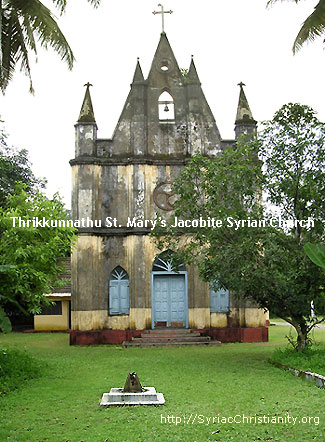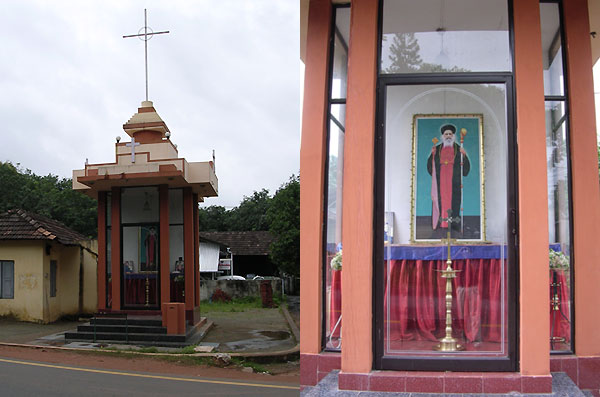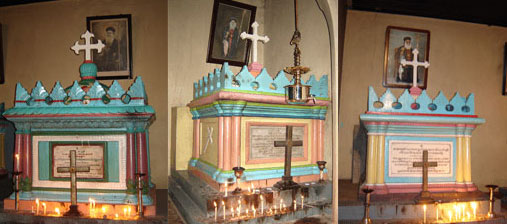|
|
 |
St. Mary's church at Thrikkunnathu, Aluva, was founded in the late 19th century by Metropolitan Mor Kurillos Geevarghese Ambattu, the first primate of the Angamali diocese and the nearby Seminary was founded by his immediate successor Metropolitan Mor Athanasious Paulose Kadavil (Sr.). Though the credit for the founding of the church and seminary is generally attributed to the first two metropolitans of Angamali diocese, the one behind its execution and development was their successor St. Athanasious Paulose, who is affectionately called 'Valiaya Thirumeni', by the Malankara Syrian Christians. Ordained as the third Metropolitan of Angamali diocese in 1910, St. Athanasious Valiaya Thirumeni was later elevated as the 'Malankara Metropolitan' (Chief Primate) of the Jacobite Syrian Church in 1917. He breathed his last in 1953 and was entombed at Thrikkunnath St. Mary's church. Though this 100 year-old church is famous for the tombs of the metropolitans of Angamali diocese, it is the name of St. Athanasious Valiya Thirumeni that stands out. The feast day of St. Athanasious Valiya Thirumeni, which falls on 25th and 26th of January, is celebrated with great enthusiasm by the Malankara Syriac Christians and during that days thousands of faithful from all over Malankara visits the Holy Shrine and offer intercessory prayers at the tomb of their beloved Metropolitan.
Beginning of the Thrikkunnath St. Mary's Church
An initiative to construct a church at Aluva first came in mid-1870's. Though some meetings have been convened in this regard by Kadavil Paulose Kassisso (Paulose Mor Athanasius), Ambatt Geevarghese Kassisso (Mor Kurillos), Vadakken Paravur Kulangara Theethoos Kassisso (Angamali diocese Vicar General) and Vadakken Paravur Kulangara Geevarghese Kassisso, nothing fruitful happened at that time. In 1876, Kadavil Paulose Kassisso and Ambatt Geevarghese Kassisso were ordained Metropolitans by name Mor Athanasius and Mor Kurillos by the Patriarch of Antioch Mor Ignatius Pathros IV for the newly formed dioceses of Kottayam and Angamali respectively. After taking charge of the Angamali diocese as its first Metropolitan, Mor Kurillos once again began his efforts to build a church at Aluva. Finally in 1880, Mor Kurillos was granted permission by the Government to construct a church at the present Thrikkunnathu village in Aluva and the said 18 acres of land was allotted to the Metropolitan on behalf of the Angamali diocese. It was Kothamangalam Marthoma church (Cheriapally), one of the wealthiest churches in Angamali diocese that donated the bulk of the amount required for buying the property.
On Kumbam 19, 1064 (1889), Metropolitan Mor Kurillos Ambattu laid the foundation stone for the new church in the name of Mother of God and offered the first Holy Qurbono. In addition to the help received from the Angamali-Akaparambu parish, Mor Kurillos has spend his own personal savings for the construction of the church. Inspite of all these he could make only a small church thatched with coconut leaves. In those days only two Jacobite families, Thenumgkal and Ambattu, were residing at Aluva and for them the new church was a great blessing. It was the priests from Angamali-Akaparambu parish who served the church till the last of Kurillos Thirumeni. Whenever he was at Thrikkunnathu, His Grace used to stay in the small shed like structure built adjacent to the church Madbho. On 9th March 1891, Mor Kurillos Ambatu thirumeni passed away and Mor Athanasious Paulose Kadavil of Kottayam diocese was appointed as the new Metropolitan for the Angamali diocese.
|
Founder of Thrikunnath church & 1st Metropolitan of Angamali |
Founder of Thrikunnath Seminary & 2nd Metropolitan of Angamali |
Malankara Metropolitan & 3rd Metropolitan of Angamali |
|||
|
|
|
|||
|
d. March 9, 1891 entombed at Angamali church |
d. November 2, 1907 entombed at Thrikunnathu church |
d. January 25, 1953 entombed at Thrikunnathu church |
|||
After a few years, the Metropolitan Mor Athanasious Kadavil shifted his residence to Thrikkunnathu where a small house was already constructed by the side of the existing church. It was around that time Kooroyo Kuttikattil Pynadathu Paulose begins his stay at thrikkunnathu along with the Metropolitan and this was after his matriculation at CMS School, Kottayam. After his studies he was teaching at the Kottayam Syrian (old) Seminary. The young deacon was brought to Thrikkunnathu by Kadavil Thirumeni to supervise the construction of the uncompleted Church and also for the general development of the place. In 1898, the deacon was ordained Kassisso and later, Ramban, by St. Gregorios Geevarghese (Parumala Thirumeni) after which he came to be popularly known as "Kochu Paulose Ramaban". The newly ordained Ramban was later summoned to Parumala by Mor Gregorios Kochu Thirumeni and was entrusted with the charge of construction of the new seminary at Parumala. By the time Kochu Paulose Ramaban left for parumala, the construction of the church at Thrikkunnathu was almost completed under the supervision of Ramban himself except for the front elevation, which was later completed by 'Malabar Threesus Subho society' (an organization of priests and laymen of Northern dioceses formed under the leadership of Konattu Mathen Malpan in 1892). The Ramban was actively involved in giving shape to Parumala Dayro, staying there for almost three years. On completion of the work there, he returned to Alwaye and took the initiative to construct the new seminary building and the house in the plot situated on the southern side of the Thrikkunnathu St. Mary's church.
On 2 November 1907, Kadavil Paulose Mor Athanasious who was the second Metropolitan of Angamali diocese passed away and was entombed near to the Madbho (on northern side) of the Thrikkunnathu St. Mary's Church. His Grace was the first Metropolitan entombed in the church. Subsequently on 9th June 1910, the then visiting Patriarch Mor Ignatius Abbed Aloho II of the holy throne of Antioch & all the East, ordained Kutikkattil Pynadathu Kochu Paulose Ramban as the third Metropolitan of the Angamali diocese by name MOR ATHANASIOUS. The headquarters of the Angamali diocese continued to be thrikkunnathu Seminary. On assumption H.G. took maximum effort to elevate the just started seminary as a major teaching center for the clergy in the northern dioceses and also came forward with many measures for the welfare of the faithful, particularly the poor in the Church. In those days Aluva was a place where only a very few Jacobite families resided. The first Syrian Christian families who settled around seminary were brought to the place under the initiative of Kadavil thirumeni Sr. before 1905. Following the path of his predecessor, Valiya Thirumeni also in his initial years itself, persuaded many number of Jacobite Syrian Christian families from nearby places like Pallikkara, Kuruppumpady, Kolencherry, Mulanthuruthy etc. to come to Thrikkunnathu and gave them land at a very nominal, or even at free of cost, in and around seminary. For their settlement the holy father sold a major portion of his ancestral property and also spend a great amount of his money and effort for the welfare of these new settlers. They were all subsequently given membership at the Thrikkunnath St. Mary's church. Later when Aluva began to develop as an industrial area, many more Jacobites who came here in search of job has also been given membership in the parish. The compound wall now seen around the church and seminary property has been constructed during this time to demarcate the boundary. Because of his sincerity and dedication, the people, not only the Jacobites, but all those who had met the holy father atleast once, loved and respected him a great.
Shrine dedicated to St. Athanasius Valiya Thirumeni situated on the main road side near to the road leading
to Thrikkunnath St. Mary's Church and the nearby Seminary
 |
Mooron Consecration of the reconstructed Thrikkunnath church
In early 1930's the Thrikkunnathu St. Mary's Church was reconstructed in its present form by Mor Athanasious Paulose Valiya Thirumeni. His Grace wanted the visiting Patriarch Mor Ignatius Elias III to consecrate the church, but H.H's unexpected death at Manjinikkara shattered his dreams. On Meenam 24, 1107 (6th April 1932) the Thrikkunnath St. Mary's church was consecrated with Holy Mooron by Mor Clemis Yuhanon, the Suryoyo Metropolitan who came along with Patriarch St. Ignatius Elias III. The patriarchal delegate to Malankara Mor Julius Elias and Mor Athanasius Paulose (Valiya Thirumeni) assisted Mor Clemis during the consecration ceremony.
After serving the Jacobite Syrian Church as its Malankara Metropolitan and the Angamali diocesan bishop for more than four decades, St. Athanasious Paulose who was affectionately called 'Valiya Thirumeni' by the Malankara Jacobite Christians, passed away on 25th January 1953. The mortal remains of the holy father was entombed on 26th in the room situated in north, adjacent to the madbho and next to the tomb of his immediate predecessor and Metropolitan of Angamali and Kottayam dioceses H.G. Mor Athanasious Paulose Kadavil (Sr.).
In 1964, the church was extended westwards during the tenure of Mor Gregorios Geevarghese Vayaliparambil, the Valiya thirumeni's successor Metropolitan of Angamali diocese. However the main structure of the church constructed by Valiya Thirumeni remained unaltered. The responsibility for the renovation works fell on Rev. Fr. Abraham Alukkal (present Metropolitan of Angamali region H.G. Mor Severios Abraham), the then vicar of the church and he has done it very efficiently. The organization by name 'Social Service league' formed during that time under the leadership of Fr. Abraham Alukkal has helped a great in collecting money for not only the construction of the church but also to help the poor in the parish. It was this society that constructed an open stage near to the church. Later during the Mor Gregorios' successor's time, the society has put a great effort to construct a hall in memory of St. Athanasious Valiya Thirumeni on the North-East side of the church, but unfortunately nothing could materilise then due to irresponsible attitude of some. On 6th November 1966, His Grace Mor Gregorios Vayaliparambil, the fourth Metropolitan of Angamali diocese also passed away and was entombed near to the tombs of his predecessors. Thus the Thrikkunnath St. Mary's Church got the sacred tombs of three holy fathers of the Malankara Jacobite Syrian Church, which naturally makes its a holiest of holy places.
|
4th Metropolitan of Angamali diocese |
|
|
d. November 7, 1966
entombed at Thrikunnathu church
Patriarchs who visited the Thrikkunaath St. Mary's Church
Three Patriarchs of the Holy See of Antioch & all the East, Mor Ignatius Abdedí Aloho, St. Ignatius Elias III and Mor Ignatius Ya`qub III had visited this church and celebrated Holy Qurbono during their apostolic voyages to Malankara in 1911, 1931 and 1964 respectively. Along with Patriarch Ya`qub III, Metropolitan Mor Severious Zakka who is the present patriarch of the Holy See had also visited this church. As mentioned before the church is blessed with the sacred tombs of Malankara Metropolitan St. Athanasius Paulose Pynadathu (Valiya Thirumeni, 1953) and the former Angamali diocesan Metropolitans, Mor Athanasius Paulose Kadavil (1907) and Mor Gregorios Geevarghese Vayaliparambil (1966). Their tombs are situated side by side, in a room adjacent to the Madbho of the church on the northern side. When Malankara Orthodox Church's Angamali diocesan Metropolitan Philipose Theophilose who was staying at Seminary died in 1997, he was entombed just outside, but adjacent to the St. Mary's church which was later converted as an separate room. The church have four shrines under its ownership in different places of Aluva town; two of them are dedicated to the Holy Virgin Mary and the other two are named after Mor Kuriakose Sahdo and Patriarch St. Ignatius Elias III of Manjinikkara. A few years back another holy shrine in the name of St. Athanasius Valiya Thirumeni has been founded near to the entrance of the Thrikkunnath church by the Angamali diocesan council of the Jacobite Syrian Church. Unfortunately the Thrikkunnathu St. Mary's church, which is one of the most important parishes of the Jacobite Syrian Christians, is remaining closed for the last 25 years due to certain disputes and claims raised by a section in Malankara.
Sacred tombs of (1) Paulose Mor Athanasius (Kadavil Sr.), (2) St. Paulose Mor Athanasius (Valiya Thirumeni)
and (3) Geevarghese Mor Grergorios (Vayaliparambil)
 |
Mass Hall, the service center of the Jacobite Syrian Church
As the St. Mary's church is remaining closed due to disputes, the Jacobite Syrian Christians of this parish now uses the 'Mass Hall', located at a few distance away from the St. Mary's Church, as their chapel. Various spiritual organizations like the Jacobite Syrian Sunday School, Martha Mariam Samajam, Youth Association, Anthiochea Viswasa Samithi, Family forums etc., functions in this church.
Every year thousands of pilgrims visit the St. Mary's church on 25th and 26th January, to pray and participate in the dukrono celebrations of St. Athanasious Valiya Thirumeni, one of the most revered Metropolitans of Malankara Syrian Church after St. Gregorios of Parumala. Conferring to the wishes of multitude of faithful in Malankara, the supreme head of the Universal Syrian Orthodox Church Patriarch H.H. Ignatius Zakka I, on 19th August 2004, issued the historic bull canonizing Mor Athanasious Paulose Valiya Thirumeni as Saint of Malankara Church. The sacred tombs of three of their most important primates in Malankara makes the St. Mary's church at Thrikkunnathu a holy place for the Jacobite Syrian Christians.
|
Another View of the Thrikkunnathu St. Mary's Church at Aluva
|
MASS HALL located at a few distance from Thrikunnathu Church
|
|
The Holy Qurbono and other services of the Jacobite Syrian Christians are held in this rented building (Mass Hall) which is being used as a Chapel for almost a quarter of the century after the main Church was closed in 1970's.
|
Aluva Thrikkunnathu Church & Seminary (articles in malayalam)